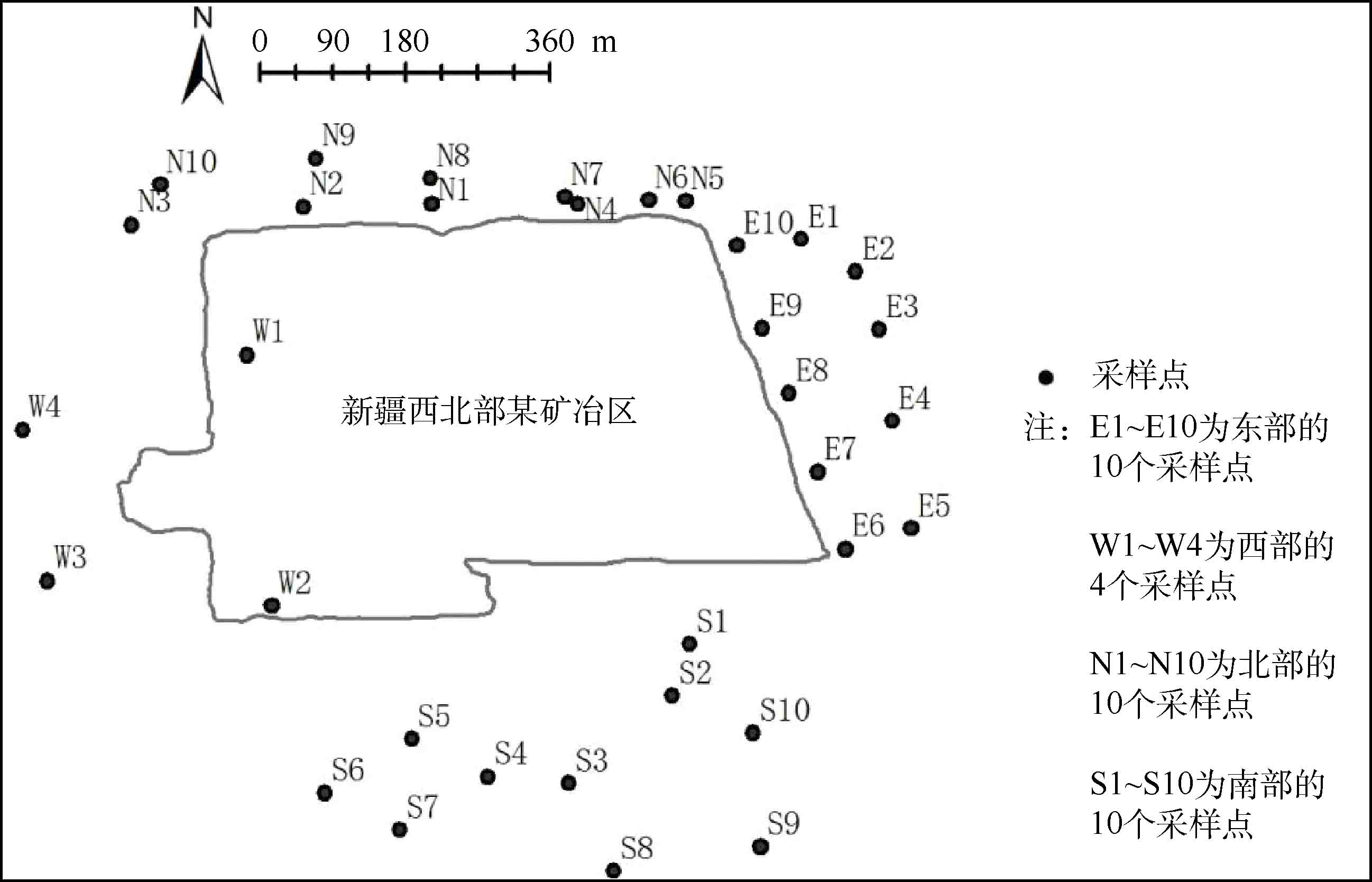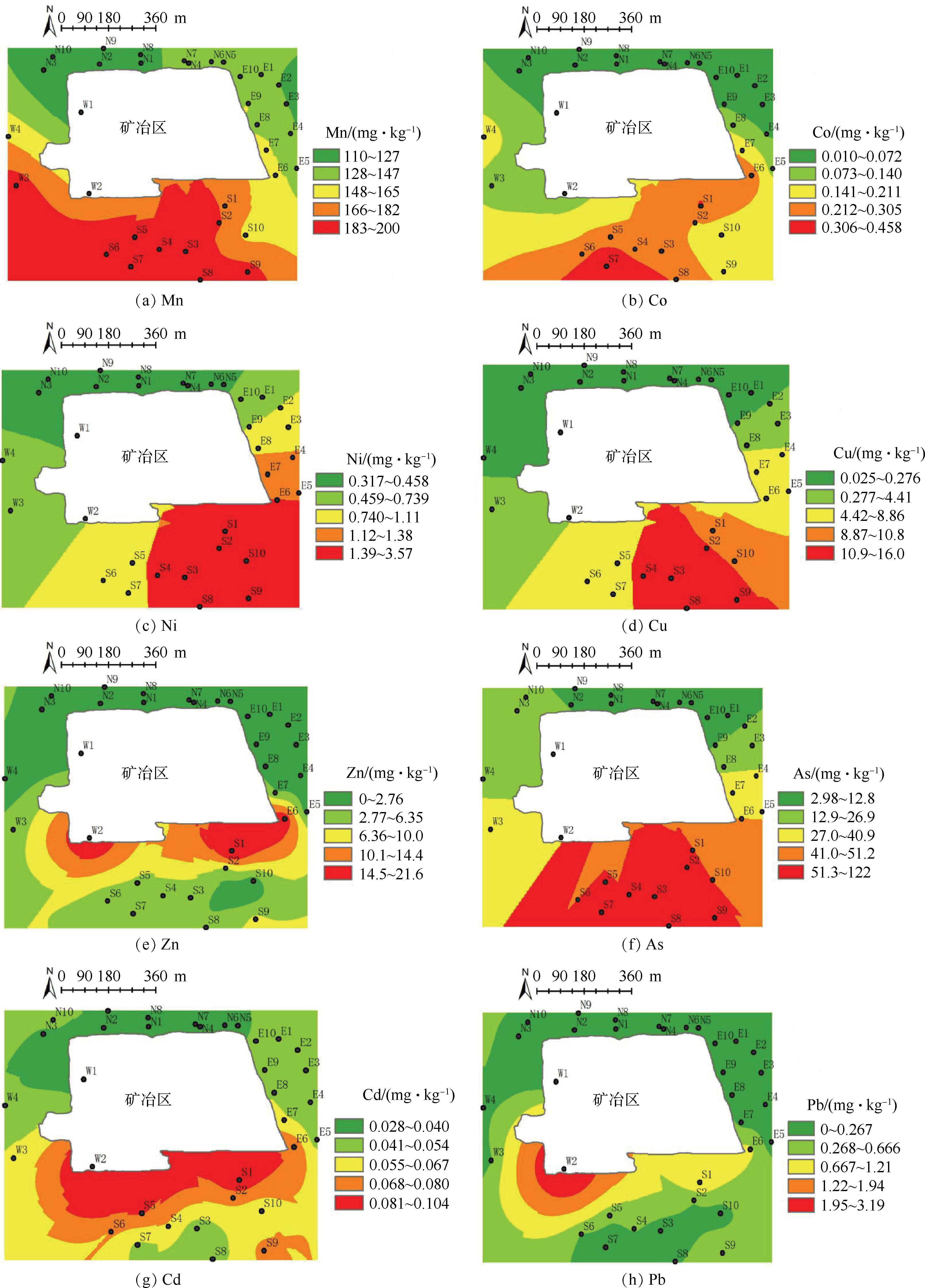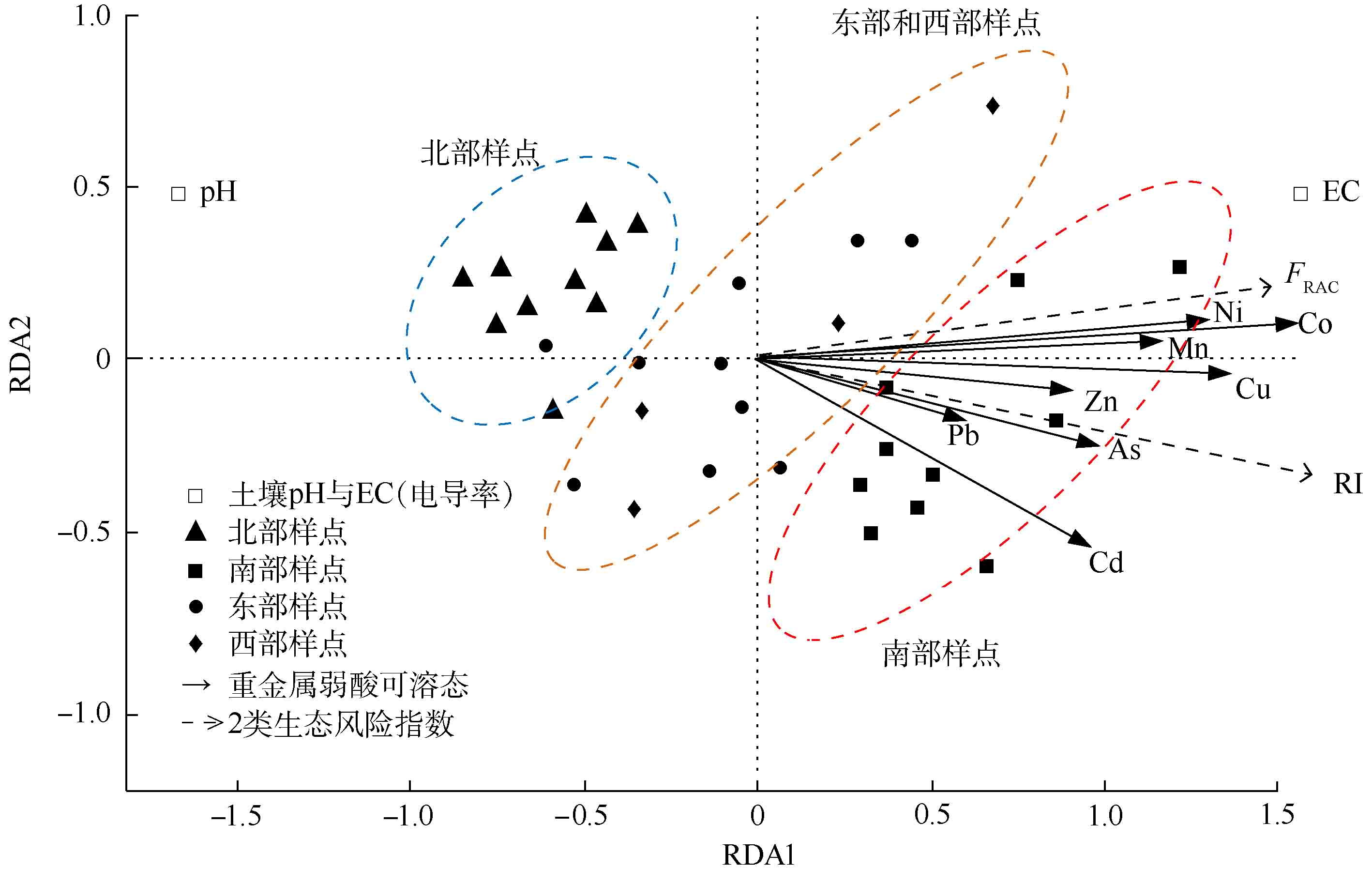全文HTML
--> --> --> 我国土壤重金属污染形势严峻,矿区周边土壤污染事件频发[1-2]。李乔等[1]对新疆准东煤田周边农田土壤重金属研究发现,Cd和Hg污染风险较高,威胁农作物安全和人体健康。胡锋等[2]对新疆伊犁矿区土壤重金属Cd、Ni、Pb、Cr、Cu和Zn进行风险评价,结果显示Cu潜在生态危害程度最高。AOSTA等[3]对铅锌尾矿库周边土壤进行研究发现,Cd、Pb和Zn的迁移风险较高,对植物的危害较大。土壤重金属生态风险评估作为区域资源开发和污染控制策略指定的重要参考而受到国内外****的广泛关注[4-5]。传统土壤重金属生态风险评价的方法(单因子指数法、富集系数法、污染负荷指数法和内梅罗综合指数法等)可对区域土壤重金属污染情况进行初步评估[6]。但由于重金属活性、土壤理化性质和土壤背景值的显著差异,单一方法的评价结果存在很大的不确定性,难以充分反映区域土壤重金属污染的风险状况[7]。潜在生态风险指数法考虑到不同地区土壤的背景值,结合生态环境效应和毒理水平对生态危害进行评估,具有简单、精确且相对快捷的特点[8]。WANG等[9]应用潜在生态风险指数法对内蒙古某金矿区的某河段表层土壤重金属进行了风险评价;陈莹[10]应用潜在生态风险指数法对陕西西部矿区土壤重金属污染进行了风险评估。然而重金属的释放迁移轨迹与方向和其存在的化学形态有密切关系[11]。近年来,国外****提出的风险评价编码法(RAC)可通过分析重金属形态分布特征来评价其对生态环境产生的风险[12],然而相关研究在国内还较薄弱。在欧共体改进的BCR法中,弱酸可溶态被确定为生物有效态,它和植物、生物中重金属含量间具有很强的相关性[13],可以反映重金属在土壤中的生物有效性。ZHANG等[14]研究发现铅锌矿区周围土壤Ni和Cu弱酸可溶态含量与玉米中的Ni和Cu含量呈显著相关(相关系数分别为0.75和0.62,P<0.01)。LIAO等[15]对广东省南部大宝山矿区进行研究发现,BCR法提取的土壤Zn和Cd弱酸可溶态含量与谷粒中Zn和Cd含量呈显著相关(相关系数分别为0.82和0.78,P<0.01),与芥菜中含量也呈显著相关(相关系数分别为0.87和0.69,P<0.01)。因此,在进行重金属生态风险评价时,对重金属化学形态的考虑就显得尤为重要。
鉴于针对生态环境脆弱地区矿冶区土壤重金属生物有效性和土壤理化性质以及生态风险关系的综合风险评价研究较少,因此,本研究以新疆某矿冶区为例,综合潜在风险指数法和RAC风险编码法,结合空间分析,对区域土壤重金属污染进行综合评估,并应用冗余(RDA)分析识别了影响风险水平的关键土壤因子,研究结果既可为当地主要污染物控制及资源可持续开发提供科学支撑,也可为其他地区土壤重金属污染风险评估提供参考。
1.1. 研究区概况
研究区位于新疆西北部某矿冶区,地形为西北高、东南低,属于温带大陆性半干旱气候。研究区有河流流经,土地利用类型以草地为主。区域降水量少,风沙大,植被稀少(覆盖率低于30%),生态环境极为脆弱。矿冶区年可冶炼加工黄金2 t,生产硫酸3.5万t,产值达4.4亿元以上。矿冶区采用氯化挥发法提取黄金。频繁的矿业活动增加了区域环境重金属污染风险,已引起当地民众和政府部门的广泛关注。1.2. 样点分布
根据研究区地貌特征和常年盛行风向,围绕矿冶区在东(E)、西(W)、南(S)、北(N)4个方向,共设置34个样点,样点位置见图1。应用矩形(10 m×10 m) 5点混合采样法,采集表层土壤(0~10 cm)。在矿冶区E、S、N 3个方向,采集10个土壤样品,编号为N1~N10、E1~E10和S1~S10;在矿冶区W方向,采集4个土壤样品(接近矿山),编号为W1~W4。1.3. 样品处理与分析
土壤样品经风干、研磨后,过2 mm筛,用于测定土壤pH和EC、有机质等基本土壤理化性质。土壤As采用王水(HCl-HNO3,3∶1)进行水浴消解[16];其余重金属采用四酸法(HCl-HF-HNO3-HClO4,10∶3∶3∶1)[17]进行消解;采用BCR法[18]对重金属的弱酸可溶态(F1)、可还原态(F2)、可氧化态(F3)和残渣态(F4)进行形态分析。采用ICP-OES (Prodigy7,Leemanlabs,USA)测定Mn和Cu含量;采用ICP-MS (NexION 300x,PerkinElmer,USA)测定土壤Zn、Cr、Ni、Co、Cd和Pb含量;采用AFS(AF-610B,北京瑞利)测定土壤As含量。在实验过程中,采用GBW07447(国家土壤标准物质)进行质量控制,测得标准回收率为85.3%~107.3%。1.4. 风险评价
1.4.1. 单因子风险评价
单因子污染指数法[19]计算方法见式(1)。式中:Pi为重金属元素污染指数;Ci为重金属元素实测值,mg·kg?1;Si为重金属元素的评价标准值,mg·kg?1,本研究采用新疆土壤重金属背景值[20]。
1.4.2. 潜在生态风险指数评价
潜在生态风险评价[21]计算方法见式(2)和式(3)。式中:Eir为单项重金属潜在风险指数;
式中:IRI为重金属综合潜在风险指数。根据Eir和IRI,可将重金属划分为低生态风险(Eir<40,IRI<150)、中等生态风险(Eir为40~80,IRI为150~300)、高生态风险(Eir为80~160,IRI为300~600)、较高生态风险(Eir为160~320)、极高生态风险(Eir>320,IRI>600)[23]。
1.4.3. RAC风险评价编码法
RAC风险评价编码法[24]计算方法见式(4)。式中:CF1为弱酸可溶态含量,mg·kg?1;CF2为可还原态含量,mg·kg?1;CF3为可氧化态含量,mg·kg?1;CF4为残渣态含量,mg·kg?1;FRAC为单一重金属弱酸可溶态占4种形态总和的百分比。根据RAC风险指数,将风险划分为无风险(FRAC<1)、低风险(FRAC为1~10)、中等风险(FRAC为10~30)、高风险(FRAC为30~50)以及极高风险(FRAC>50)[25]。
1.4.4. 数据分析
应用普通Kriging(ArcGIS 10.4)进行空间插值分析。采用SPSS19.0和R3.4.3对数据进行统计分析。使用SigmaPlot12.5作图。重金属弱酸可溶态含量数据经对数转换后,进行正态分布检验(Shapin-wilk检验,P<0.05)。2.1. 土壤重金属含量特征
研究区土壤pH为7.64~8.91,EC为77.3~1 402 μS·cm?1,有机质为14.7~32.5 g·kg?1,这符合西北干旱区典型土壤基本特征[26]。研究区土壤重金属全量与弱酸可溶态含量统计分析结果如表1所示。土壤重金属As(1.7~1 730 mg·kg?1)和Cu(3.4~1 809 mg·kg?1)全量变幅较大,变异系数分别为114%和172%。研究区土壤As和Cu超标率分别为88%和38%;Zn与Cd在少数点位有超标现象,超标率分别为24%和6%,而Mn超出背景值的比例为49%。土壤Mn、As、Cu弱酸可溶态含量平均值较高,分别为8.94、4.51和3.95 mg·kg?1;土壤Cu、Pb、Zn、Co和As弱酸可溶态含量变异系数较大,分别为274%、208%、169%、137%和131%;单因子污染指数评价显示,As和Cu污染风险较高,其风险指数值分别为41.9和8.28;As(431)的潜在生态风险指数最大,其次为Cd(107)和Cu(42.6);而Mn的RAC风险指数最大,为22.1%,其次为As和Cd,分别为16.5%和13.1%。综上所述,研究区土壤As、Cu、Cd和Mn存在一定污染风险,As和Cu受人为活动影响,并存在显著累积现象。2.2. 土壤重金属生物有效性
应用ArcGIS空间分析模块绘制了土壤重金属弱酸可溶态含量空间分布图,结果如图2所示。研究区土壤重金属弱酸可溶态含量空间分布格局整体上较为类似,都是北边较低,南边接近矿冶区的部分区域较高,离矿冶区一定距离后由高向低转变。其中土壤Co、Cu和Ni弱酸可溶态含量高值区主要集中在接近矿冶区东南边的尾砂库区域,如图2(a)~(d)所示。土壤Pb弱酸可溶态含量高值区主要集中在矿冶区南边偏西的收砷房附近,如图2(h)所示。土壤Mn、Zn、As和Cd弱酸可溶态含量高值区主要集中在矿冶区南边偏西的收砷房和东南边的尾砂库区域附近,如图2(f)~(g)所示。进一步分析土壤Mn、Cd、As和Cu重金属形态分布特征,结果如图3所示。弱酸可溶态所占比例从大到小依次为Mn>Cd>As>Cu(平均值)。在不同的方位,同一种金属的弱酸可溶态所占比例会有所不同,Mn在南边、Cu在东边、As在西边均出现较大比例分布,而Cd在不同区域相差较小。而重金属弱酸可溶态可以被生物直接吸收利用,对生物的危害较大[28]。因此,土壤Mn相对于Cd、As和Cu对生物的危害较大。可还原态在土壤环境中一般比较稳定,但随着pH和Eh等的改变,会被还原成弱酸可溶态,存在潜在对生物危害的风险[29]。土壤Mn、Cd、Cu和As可还原态所占比例与弱酸可溶态类似,而分布却不同;Mn可还原态比例在北边最高,As、Cd和Cu均在东边和西边最高,说明除Mn潜在毒性风险在北边较高外,其余3种重金属的潜在毒性风险均在东边和西边较高。可氧化态比例以As和Cu在南边最大,Mn和Cd相对较小。残渣态较为稳定,其中Cu在北边所占比例最大。李忠义等[30]的研究也发现土壤Cd、Zn和Cu等重金属弱酸可溶态在靠近尾砂库附近区域含量较高。由此可见,区域矿业活动对土壤重金属生物有效性存在显著影响。
2.3. 生态风险评价
单项重金属潜在生态风险指数评价结果如图4(a)所示。土壤As极高风险所占比例最大,为41%,中等风险比例为18%,而较高风险和高风险比例均未超过10%;Cu的中等生态风险与高生态风险所占比例分别为18%和6%,而较高生态风险和极高生态风险比例各占3%;Cd中等生态风险样点所占比例最大,为50%,高生态风险和较高生态风险所占比例分别为27%和18%,极高生态风险比例仅为3%;土壤Pb有1个样点处于中等风险水平,其余重金属元素均处于低生态风险水平。综合生态风险指数(RI)评价结果显示:研究区8种土壤重金属极高生态风险比例最大,约为41%;其次为低生态风险,所占比例为38%;中等生态风险和高生态风险比例分别为15%和6%。其中As、Cd和Cu对区域土壤重金属潜在生态风险水平贡献率显著高于其他元素。RAC风险编码法评价结果如图4(b)所示。土壤Cu、Zn、Pb、Ni和Co所有样点RAC风险指数均小于10%,处于低风险或无风险水平。值得注意的是,土壤Mn有5个样点风险指数为30%~47%,处于高风险水平,27个样点风险指数为10%~30%,处于中等风险水平;土壤Cd有24个样点风险指数为10%~30%,处于中等风险水平;土壤As的RAC风险指数范围为2%~20%,平均值为7%,有7个样点处于中等风险水平。由此可知,As和Cu潜在毒性风险较高,而Cd和Mn存在一定的迁移风险,应重点关注该4种重金属污染状况。
2.4. 生态风险影响因子
应用RDA冗余分析法进一步探究了土壤pH和电导率(EC)对土壤重金属弱酸可溶态含量以及风险指数的影响,结果如图5所示。第1排序轴RDA1的贡献率达到65.1%(R2=0.69,P<0.01),8种重金属弱酸可溶态含量之间均呈现正相关关系,尤其是弱酸可溶态Co、Cu、Mn、Ni和弱酸可溶态Zn,以及弱酸可溶态As和弱酸可溶态Pb;弱酸可溶态Cd与弱酸可溶态Co、Mn、Ni等几种重金属弱酸可溶态含量无显著相关性,但弱酸可溶态As和Pb含量的相关性显著,此结果与方月梅等[31]关于矿区重金属生物有效性关系的研究结论较为类似。土壤pH与8种重金属弱酸可溶态含量均呈现显著的负相关关系。而土壤电导率(EC)与8种重金属弱酸可溶态含量均无显著相关关系(
潜在生态风险指数(RI)与土壤pH呈显著的负相关关系,另外As、Cu等8种弱酸可溶态含量总和与潜在生态风险指数和RAC风险指数均呈现显著的正相关关系。可见土壤pH的降低会显著提高土壤重金属弱酸可溶态含量,而土壤弱酸可溶态含量的升高会直接影响到对生物的危害程度,从而增加重金属污染物的生态风险[32-33]。综上所述,研究区土壤重金属弱酸可溶态含量是影响土壤重金属污染风险的直接因素,而土壤pH是影响土壤重金属污染风险的间接因素。
2)矿业活动对周边土壤重金属生物有效性存在显著影响。土壤Co、Cu和Ni弱酸可溶态高值区主要集中在接近矿冶区东南部的尾砂库区域;Pb弱酸可溶态含量高值区主要集中在接近矿冶区南部偏西的收砷房区域,而Mn、Zn、As和Cd高值区集中在尾砂库和收砷房的附近区域。
3)单因子污染指数、潜在生态风险指数、RAC风险指数,空间分析方法以及冗余分析方法的联合使用,有助于区域土壤重金属污染风险管控和科学决策。
参考文献


 下载:
下载: 



 点击查看大图
点击查看大图